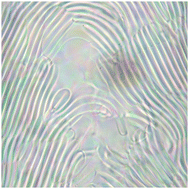Temperature dependence of the pitch in chiral lyotropic chromonic liquid crystals
Abstract
One of the most simple cases in which chirality at the microscopic level produces a chiral macroscopic structure is the chiral nematic liquid crystal phase. In such a phase, the preferred direction of molecular orientation rotates in helical fashion, with the pitch of the helix in different systems ranging from around 100 nm to as large as can be measured (∼10 mm). For almost all thermotropic and lyotropic liquid crystals, the ordered entities are formed from strong bonds, so the pitch varies in accordance with how the interactions between these largely immutable entities are affected by changing conditions. A unique exception are lyotropic chromonic liquid crystals (LCLCs) that spontaneously form weakly bound assemblies in solution, the size of which depends strongly on experimental parameters. While the temperature dependence of the pitch has been measured for chiral LCLCs formed by short strands of DNA (DNA-LCLCs), such is not the case for chiral LCLCs formed by small molecules. Polarized optical microscopy experiments on small molecule chiral LCLCs reveal the changing assembly size through a temperature dependence of the pitch not typical for many other systems, including the most recent measurements on DNA-LCLCs. In fact, the pitch measurements in small molecule chiral LCLCs strongly increase in value as the temperature is increased and the assemblies shrink in size. Theoretical considerations provide some help in understanding this phenomena, but leave much to be explained.



 Please wait while we load your content...
Please wait while we load your content...
